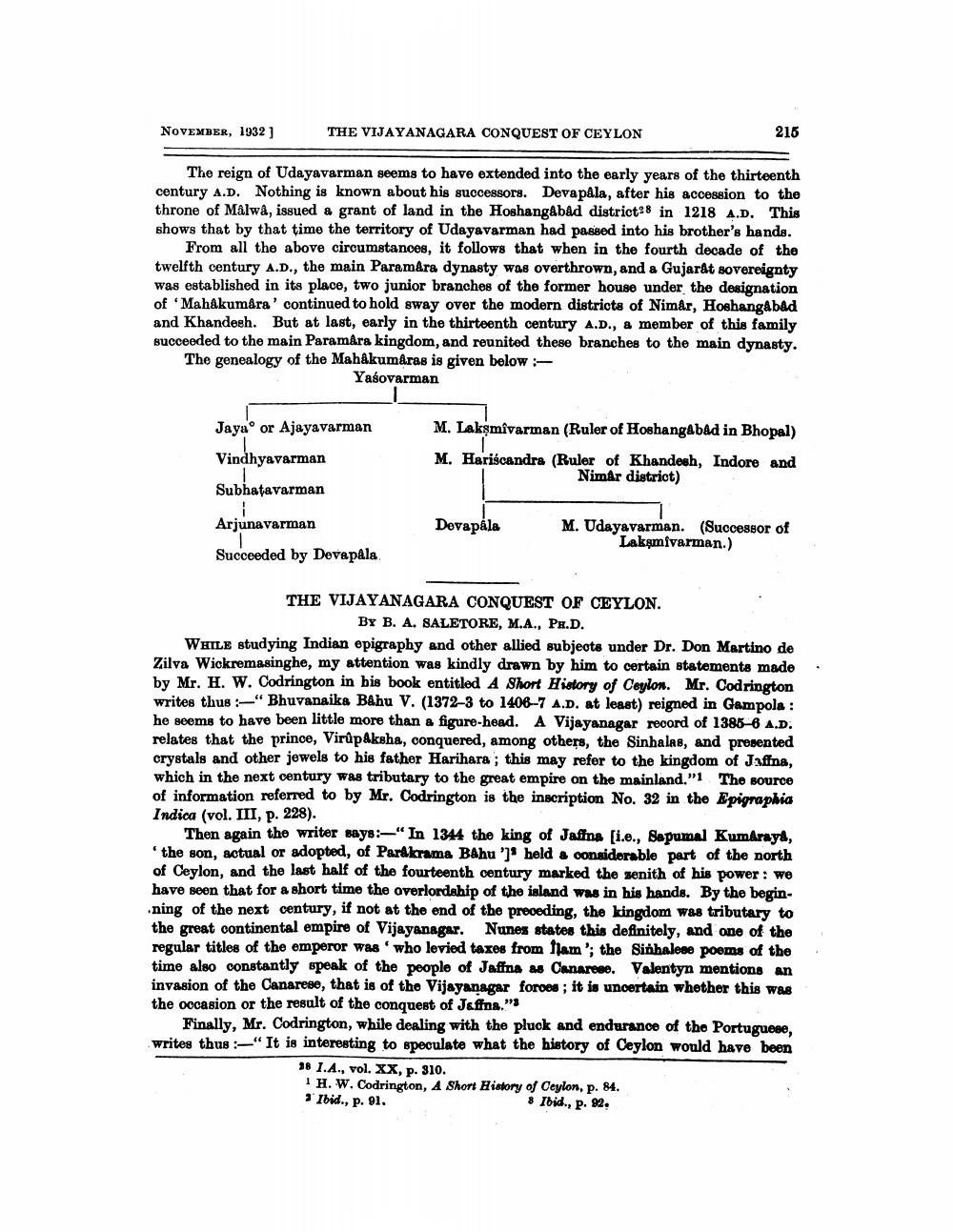________________
NOVEMBER, 1932 ]
THE VIJAYANAGARA CONQUEST OF CEYLON
216
The reign of Udayavarman seems to have extended into the early years of the thirteenth century A.D. Nothing is known about his successors. Devapala, after his accession to the throne of Malwa, issued a grant of land in the Hoshangabad district 28 in 1218 A.D. This shows that by that time the territory of Udayavarman had passed into his brother's hands.
From all the above circumstances, it follows that when in the fourth decade of the twelfth century A.D., the main Param&ra dynasty was overthrown, and a Gujarat sovereignty was established in its place, two junior branches of the former house under the designation of 'MahAkumara' continued to hold sway over the modern districts of Nimar, Hoshangabad and Khandesh. But at last, early in the thirteenth century A.D., a member of this family succeeded to the main Paramára kingdom, and reunited these branches to the main dynasty. The genealogy of the Mahakumaras is given below -
Yasovarman
Jaya or Ajayavarman
M. Lakşmivarman (Ruler of Hoshangabad in Bhopal) M. Hariscandra (Ruler of Khandesh, Indore and
Nimar district)
Vindhyavarman
Subhatavarman
Arjunavarman
Devapála
M. Udayavarman. (Successor of
Lakşmivarman.)
Succeeded by Devapala
THE VIJAYANAGARA CONQUEST OF CEYLON.
BY B. A. SALETORE, M.A., PH.D. WHILE studying Indian epigraphy and other allied subjects under Dr. Don Martino de Zilva Wickremasinghe, my attention was kindly drawn by him to certain statements made by Mr. H. W. Codrington in his book entitled A Short History of Ceylon. Mr. Codrington writes thus :"Bhuvanaika Bahu V. (1372-3 to 1406-7 A.D. at least) reigned in Gampola : he seems to have been little more than a figure-head. A Vijayanagar record of 1385-8 A.D. relates that the prince, Virupaksha, conquered, among others, the Sinhalas, and presented crystals and other jewels to his father Harihara; this may refer to the kingdom of Jaffna, which in the next century was tributary to the great empire on the mainland." The source of information referred to by Mr. Codrington is the inscription No. 32 in the Epigraphia Indica (vol. III, p. 228).
Then again the writer says:-" In 1344 the king of Jaffna [i.e., Sepumal Kumaraya, the son, actual or adopted, of Parakrama Bahu 'l' held a considorable part of the north of Ceylon, and the last half of the fourteenth century marked the zenith of his power: we have seen that for a short time the overlordship of the island was in his hands. By the beginning of the next century, if not at the end of the preceding, the kingdom was tributary to the great continental empire of Vijayanagar. Nunes states this definitely, and one of the regular titles of the emperor was 'who levied taxes from flam'; the Sinhalese poems of the time also constantly speak of the people of Jaffna as Canareee. Valentyn mentions an invasion of the Canarese, that is of the Vijayanagar foroes; it is uncertain whether this was the oocasion or the result of the conquest of Jaffna."
Finally, Mr. Codrington, while dealing with the pluck and endurance of the Portuguese, writes thus :-"It is interesting to speculate what the history of Ceylon would have been
38 1.A., vol. XX, p. 310. 1 H. W. Codrington, A Short History of Ceylon, p. 84. 3 Ibid., p. 01.
8 Ibid., p. 92.




